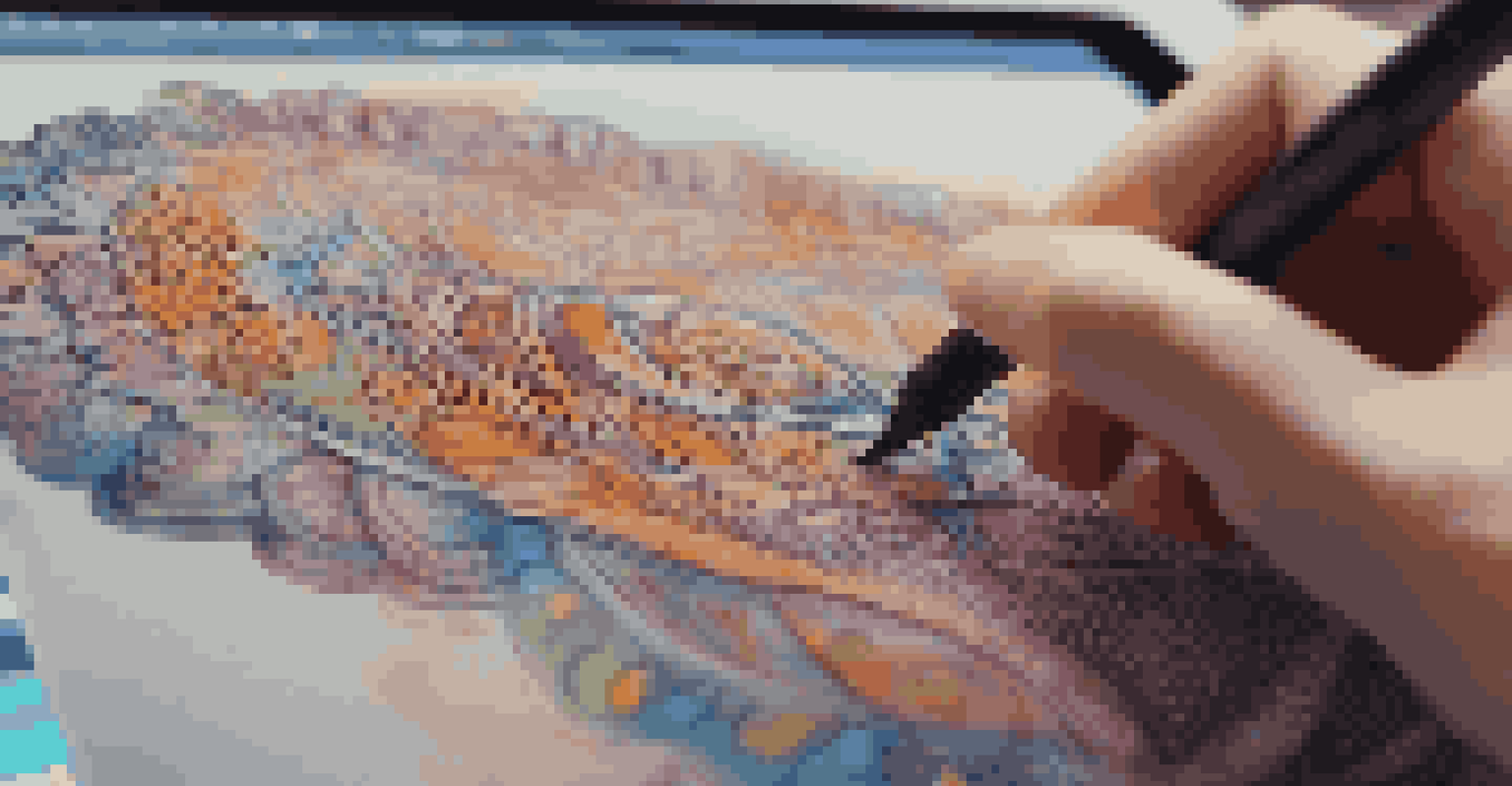Digital Art Preservation and the Role of Art Critics

The Importance of Digital Art Preservation
Digital art has revolutionized the creative landscape, but its transient nature presents unique challenges. Unlike traditional art forms, digital works can be easily altered or corrupted, making preservation vital for future generations. Just as classic paintings are cherished and restored, digital creations deserve similar attention to ensure their longevity.
Digital art is not just a new medium; it's a new way of seeing and thinking about art and its preservation.
Preserving digital art involves not just saving files but also maintaining the context in which they were created. This includes understanding the software used, the artist's intentions, and the cultural significance of the work. Failing to consider these aspects can lead to a loss of meaning and relevance over time.
As technology evolves, new formats and platforms emerge, necessitating ongoing efforts to adapt preservation strategies. Digital art is often experienced through specific software or hardware, which can become obsolete. Therefore, continuous evaluation and updating of preservation techniques are essential to keep digital art accessible and meaningful.
Challenges in Preserving Digital Art
One of the primary challenges in digital art preservation is file corruption. Just like a beloved family photo that fades over time, digital files can degrade due to software malfunctions or hardware failures. Regular backups and the use of stable formats are crucial to mitigate this risk.

Another hurdle is the rapid pace of technological change. A digital artwork created a decade ago might require outdated software to view, making it inaccessible to future audiences. This highlights the necessity for artists and institutions to proactively plan for the future of their works.
Digital Art Needs Preservation
The transient nature of digital art requires dedicated efforts to preserve not just the files but also the context and meaning behind them.
Moreover, the ephemeral nature of online platforms poses a problem. Social media and web-based galleries often host digital art temporarily, leading to the risk of disappearing works. It's imperative for artists and curators to archive their pieces in dedicated digital repositories to ensure they remain part of the cultural conversation.
The Evolving Role of Art Critics in Digital Spaces
Art critics have traditionally shaped how audiences perceive and appreciate art. In the digital age, their role is evolving to include not just critique but also advocacy for preservation efforts. Critics can provide valuable insights into the significance of digital art, helping to contextualize it within larger cultural narratives.
The challenge of preserving digital art is not merely in keeping the files intact but in maintaining the cultural context that gives them meaning.
By engaging with digital art, critics can highlight its complexities and the unique challenges it faces. They can raise awareness of issues like copyright, accessibility, and preservation, fostering a more informed dialogue around these topics. This advocacy can lead to greater support for preservation initiatives from both the public and private sectors.
Furthermore, art critics can bridge the gap between artists and audiences in the digital realm. By articulating the nuances of digital works, they help demystify the technology behind them, making the art more approachable. This connection can encourage more people to engage with and appreciate digital art, ensuring its place in the broader art world.
The Intersection of Technology and Critique
As technology continues to advance, art criticism is also adapting. Critics are using digital tools to analyze and engage with art in innovative ways. For instance, virtual reality allows critics to immerse themselves in digital environments, offering a unique perspective that traditional critiques cannot provide.
Moreover, social media platforms are reshaping how critiques are disseminated. Critics can share their thoughts instantly with a global audience and spark conversations that transcend geographic boundaries. This immediacy can enrich the discourse around digital art, making it more dynamic and inclusive.
Technology Challenges Preservation
Rapid technological changes and file corruption pose significant challenges to accessing and preserving digital artworks for future generations.
However, this new landscape also presents challenges. The rapid spread of opinions on social media can lead to a dilution of thoughtful critique. Critics must navigate this environment carefully, ensuring their voices contribute to a deeper understanding of digital art rather than simply adding to the noise.
Case Studies in Digital Art Preservation
One notable example of successful digital art preservation is the 'Webrecorder' project, which archives web-based art. This initiative captures the dynamic nature of online artworks, ensuring they remain accessible even as the web evolves. By preserving the interactive aspects of these works, projects like Webrecorder serve as models for future preservation efforts.
Another interesting case is the preservation of 'Net Art' from the early 2000s. Many of these works faced obsolescence due to changes in technology, but archivists have stepped in to recreate the original environments. This not only preserves the art itself but also the context in which it was experienced, providing valuable insights into the era's digital culture.
These case studies highlight the importance of collaboration between artists, critics, and archivists. By working together, they can develop innovative strategies to preserve digital art, ensuring it remains a vibrant part of the art world for years to come.
Future Directions for Digital Art Preservation
Looking ahead, the future of digital art preservation holds promise but also requires ongoing commitment. Emerging technologies such as blockchain may offer new solutions for tracking and authenticating digital works, making preservation more secure. This could enhance the value and longevity of digital art, encouraging more artists to explore this medium.
Additionally, as awareness of digital art preservation grows, we can expect increased support from institutions and funding bodies. Grants and initiatives focused on preserving digital works can help ensure that artists have the resources they need to safeguard their creations. This could lead to a more sustainable ecosystem for digital art.
Education is Key to Awareness
Incorporating digital art preservation into educational programs empowers future artists and critics to prioritize safeguarding these works.
Ultimately, the collaboration between artists, critics, and preservationists will be crucial. By fostering a community dedicated to understanding and maintaining digital art, we can ensure that these innovative works continue to inspire and engage audiences in the future.
The Role of Education in Digital Art Preservation
Education plays a vital role in promoting awareness around digital art preservation. By incorporating these topics into art curricula, students can learn the importance of safeguarding digital works from the start of their careers. This knowledge will empower the next generation of artists to prioritize preservation in their practice.
Workshops and seminars focusing on digital art preservation can also bridge the gap between artists and critics. These events create opportunities for dialogue and collaboration, fostering a deeper understanding of the challenges and solutions in this field. Educational initiatives can cultivate a community that values both digital art and its preservation.

Additionally, as more institutions embrace the significance of digital art, they can offer specialized programs to train professionals in digital archiving and preservation techniques. This expertise will be essential as the demand for preservation grows, ensuring that digital art remains accessible and appreciated in the years to come.